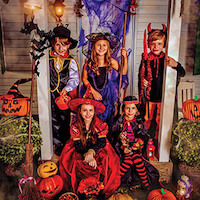Many parents find that anywhere between ages 11 and 13 are good times to let their children go trick-or-treating with friends. However, this decision may be based on several factors.
Kids go through many rites of passage throughout childhood. There is the first time they go to school and leave parents behind for several hours per day. Another rite is sleeping over at a friend or family member's house or even summer camp. Still another may be being allowed to attend a movie alone with a friend. Small rites of passage signify a child is getting older and is ready for more responsibility and trust. Such may be the case when parents conclude that their children are ready to engage in Halloween fun without an adult chaperone.
There is no set age when a child can walk around the neighborhood trick-or-treating unattended. Just as with other tests of responsibility, such as staying home alone or being able to ride bikes with friends, it is up to parents to gauge their youngsters' readiness. Halloween for older children often is less about candy and more about hanging out with friends. Therefore, parents probably needn't worry that their kids will be traveling solo since a large group of children will likely be visiting homes together. Many parents find that anywhere between ages 11 and 13 are good times to let their children go trick-or-treating with friends. However, this decision may be based on several factors.
· Time of day: It's best to limit a first time trick-or-treating without parents to daylight hours. What looks familiar during the day may be less familiar after sunset. It's generally safer for kids to be out and about before night falls.
· Other participants: Parents should weigh the personalities of their kids' friends as well. For those who are assured that others in the group are mature and responsible, there's no need to continue to clip the proverbial wings of trick-or-treaters. But if parents are leery of any shenanigans that may take place, it may be better to wait things out a little longer.
· The neighborhood: Is the area relatively safe with limited vehicle traffic? If so, then parents may feel more comfortable letting kids on the younger range of that age spectrum trick-or-treat without them. Urban neighborhoods or ones where houses are separated by a lot of land may warrant some adult supervision.
· Constant contact: Parents who utilize GPS apps to keep tabs on their children's whereabouts may feel more comfortable letting them trick-or treat with friends. These apps will show exactly where the child is at the time and can trace the route kids take. Many children get smartphones while young, which can alleviate concerns about getting in touch or keeping track of kids left to their own devices.
When to let kids go out trick-or-treating without adults is a decision each family needs to make based on their unique circumstances and preferences.


